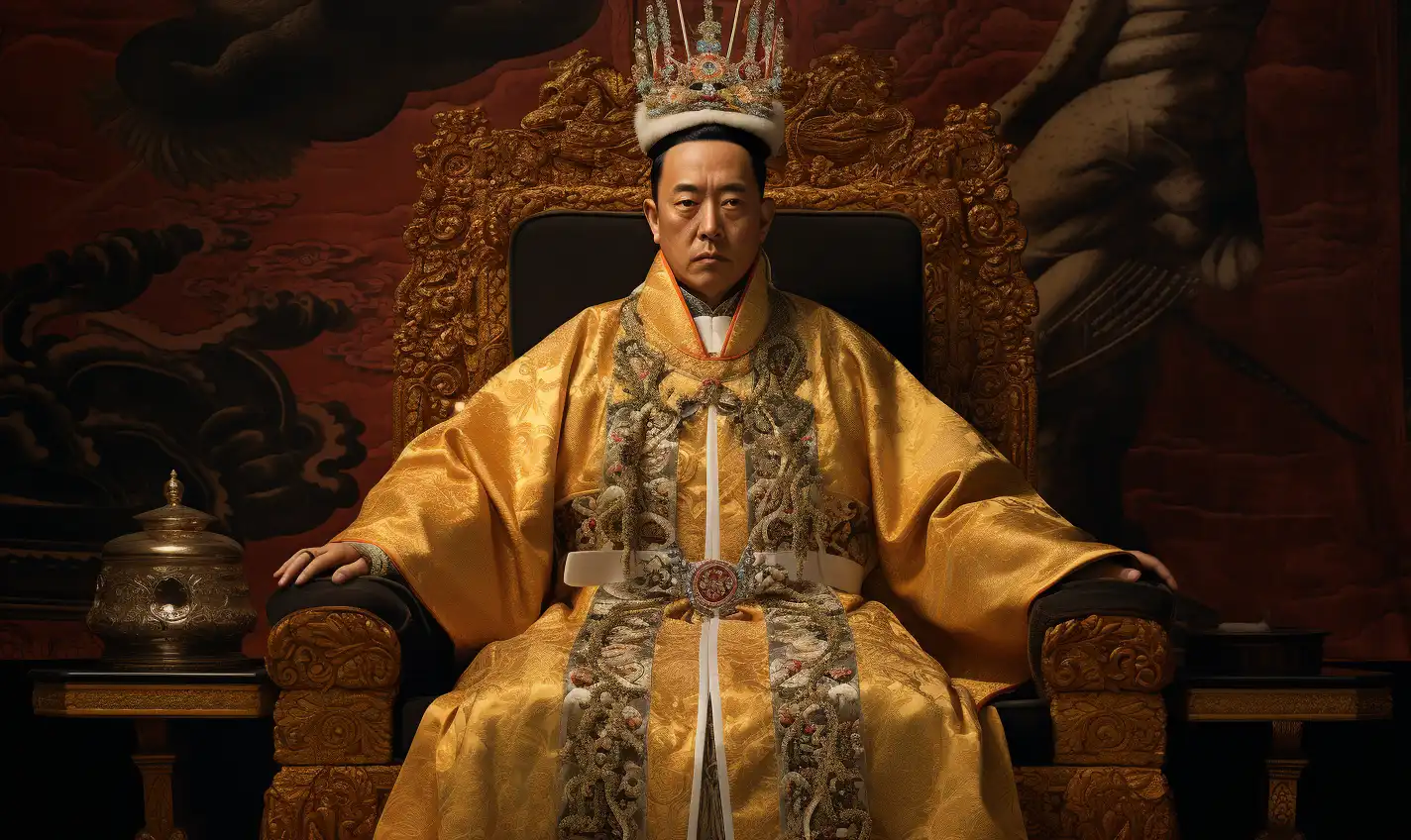Baihu: The One of the Four Symbols of Chinese Mythology

Introduction
The White Tiger, or Baihu in Chinese, is one of the Four Symbols of Chinese mythology. The Four Symbols are four celestial creatures that represent the cardinal directions and seasons.
Each creature has its own unique attributes and cultural significance. The White Tiger represents the west and the autumn season.
According to Chinese mythology, it is said that Baihu was created by the Jade Emperor himself as a guardian of the West. The White Tiger is often depicted as a fierce warrior with powerful claws and sharp teeth, ready to protect and defend.
Brief history and background of Baihu
Baihu’s history can be traced back to ancient China during the Han Dynasty (206 BCE – 220 CE). It was during this time that Chinese astrology became popularized, with each constellation having its own unique story and symbolism.
In Chinese mythology, Baihu is revered for its strength and power. As one of the Four Symbols, it represents a fundamental aspect of Chinese culture.
The White Tiger’s perceived courage in battle made it an important symbol for warriors in ancient times. Today, Baihu remains one of China’s most beloved mythical creatures due to its fascinating history, symbolisms, and tales associated with it.
Importance of Baihu in Chinese Mythology and Culture
Baihu’s importance in Chinese mythology stems from its representation as a guardian figure – particularly for those who follow Taoism – emphasizing protection against evil spirits or demons. In addition to being an important symbol for protection against evil spirits or demons – particularly during war times – Baihu holds special significance when it comes to divination through astrology.
Its presence serves as both a protective deity guiding people through their lives while also acting as a warning sign when things are about to go wrong or evil spirits are present. In Chinese culture, Baihu is also known for its ability to bring good fortune and luck.
Many people believed that carrying a Baihu talisman or charm would protect them from harm and bring them prosperity in life. Overall, the White Tiger holds immense cultural significance and remains a beloved symbol of strength, protection, and fortune in Chinese traditional culture.
Origin Story
Legend of how Baihu was created by the Jade Emperor
In Chinese mythology, it is believed that Baihu was created by the Jade Emperor, the ruler of heaven and all gods. According to legend, the Jade Emperor ordered four heavenly beasts to guard his throne: the Azure Dragon, Vermilion Bird, Black Tortoise, and White Tiger.
Each beast was given a cardinal direction and a season to represent. Baihu was chosen to represent the west and the autumn season.
The story goes that when Baihu was first created by the Jade Emperor, he had no colors on his fur. He looked plain and ordinary compared to other heavenly beasts.
Distressed with this look, he went on a journey to find new colors for himself. He traveled across mountains and rivers until he found a river in which he saw his reflection in its clear water.
Baihu decided that he would change his appearance by overlaying black lines over his white fur just like a tiger pattern. Upon returning back to heaven with these new markings on him there were gasps all around as such beauty had not been seen before.
The Role of Baihu in Four Symbols
The Four Symbols is an important concept in Chinese astrology representing four celestial creatures: Azure Dragon of the East (Qing Long), White Tiger of the West (Bai Hu), Black Tortoise of North (Xuan Wu), and Vermilion Bird of South (Zhu Que). These creatures are believed to control various natural phenomena such as seasons and weather patterns as well as their influence over people’s lives. Baihu holds an important position among these four symbols besides being one of them because it represents metal element which is aligned with Autumn season relating to white color too.
Baihu is often associated with bravery and strength because according to Chinese mythology Bai Hu fought many battles and emerged victorious in each one of them. Because of this, Baihu has become a symbol of protection and is often depicted as a guardian spirit on the roofs of buildings.
In Chinese culture, it is also believed that Baihu has magical powers, able to cure and ward off evil spirits. Thus, it is not uncommon to see images of Baihu in various forms such as sculptures or paintings across China as these are considered lucky charms that bring good fortune and protection from harm.
Overall, the origin story of how Baihu came into existence and its crucial role in the Four Symbols highlights the importance that Chinese mythology places on celestial creatures and their influence over human life. The cultural significance of these mythical creatures has withstood the test of time and continues to be celebrated today through art, literature, and other forms of popular culture.
Characteristics and Symbolism
Baihu’s physical appearance is that of a white tiger with black stripes, often depicted as fierce and majestic. His eyes are said to be blue or green, representing his ability to see through darkness and deception. Baihu’s size is often described as enormous, making him a formidable creature in Chinese mythology.
Aside from his physical traits, Baihu is also known for his symbolic meanings in Chinese culture. He represents bravery and strength, as tigers are considered to be one of the most powerful animals in the world.
In addition, Baihu’s role as a protector is also emphasized – he was believed to guard the west gate of heaven. The symbolism associated with Baihu extends beyond just his appearance and traits.
The tiger is one of the twelve zodiac animals in Chinese astrology, with those born under this sign thought to possess qualities such as courage and passion. As part of the Four Symbols, Baihu represents the west direction and the autumn season.
Physical Appearance
Baihu’s fur is said to be incredibly soft yet strong – this paradoxical quality reflects how he embodies both gentleness and power at once. His imposing figure adds to his intimidating presence; he stands tall on four paws with sharp claws meant for hunting prey or defending himself from enemies.
Accordingly, Baihu has become a popular figure not just in mythology but also in art; numerous paintings depict him prowling through forests or engaged in battle against other creatures who threaten his territory. This imagery reinforces the idea that Baihu should not be underestimated – despite his noble nature, he can be fiercely protective if provoked.
Symbolic Meanings
The brave aspect of Baihu comes from their role as protectors; many believed that these tigers would watch over their land and make sure no harm came to their people. Similarly, Baihu was seen as a symbol of strength, since tigers are known for their physical prowess and endurance. His ability to defend against threats and ward off evil spirits made him an important part of many Chinese rituals and festivals.
For Chinese women who were unable to stand up for themselves due to societal constraints, Baihu also became symbolic in another way – as a fierce protector of women. Some myths depict the White Tiger coming to the rescue of damsels in distress; others show him fighting off would-be assailants who sought to harm women in his territory.
The tiger’s association with power is also evident in its use as a symbol for military might; some armies even incorporated Baihu into their logos or banners as a means of inspiring fear in their enemies. In this capacity, he represented not only physical strength but also mental fortitude – qualities that any warrior would need if they hoped to succeed on the battlefield.
Baihu’s physical characteristics and symbolic meanings have imbued him with an enduring legacy that spans centuries. Even today, people continue to be fascinated by this fearsome creature – whether it be through depictions in art or references in popular culture.
Ultimately, what makes Baihu so appealing is his multifaceted nature; he is simultaneously powerful yet gentle, protective yet fierce. This duality reflects the complexity of human nature itself – which is perhaps why we continue to celebrate this mythical creature even after all these years.
Cultural Significance
Baihu, also known as the White Tiger, holds significant cultural importance in Chinese mythology and astrology. Baihu is one of the four celestial animals that are associated with the cardinal directions and seasons.
Each animal holds its own significance, but Baihu represents the west and the autumn season. Along with the other celestial animals, Baihu is used in Chinese astrology to determine fortunes based on an individual’s birth year.
Role of Baihu in Chinese Astrology and Zodiac Signs
In Chinese astrology, each year corresponds to one of twelve zodiac signs, which are represented by animals. The White Tiger is one of these zodiac symbols and represents those born in years that end with 6 or 7.
Individuals born under this sign are believed to be brave, competitive, and passionate. The symbolism behind Baihu’s role in Chinese astrology extends beyond just personality traits associated with its zodiac sign.
In Chinese culture, it is believed that wearing or displaying an image of a particular celestial animal can bring good luck or ward off bad spirits. For this reason, many people may choose to wear clothing or jewelry adorned with a representation of Baihu or incorporate its image into their homes.
Use of Baihu as a Symbol in Traditional Chinese Art and Architecture
Baihu’s symbolic significance extends beyond just astrology and into traditional Chinese art and architecture as well. The iconic image of a white tiger often appears on ancient architectural structures such as gates, temples or tombs from different regions of China.
It was widely believed that by placing images for these divine beasts around buildings would protect them from evil influences. Additionally, few artists have depicted this mythical creature using different materials like ink painting on paper or silk fabric embroidery; both techniques require mastery from artists who use them for expressing their cultural beliefs through art.
Overall, it’s clear that the White Tiger holds a significant place in Chinese culture and has had an enduring impact on the country’s art, architecture, and astrology. Through its representation as one of the four celestial animals and its role as a symbol of bravery and protection, Baihu continues to be an important part of Chinese mythology and tradition.
Mythological Tales
Retelling of the Famous Myths Involving Baihu
Baihu has played a significant role in Chinese mythology and folklore, featuring in many stories and legends. One of the most famous tales involving Baihu is his battle with Zhu Bajie from Journey to the West.
In this story, Zhu Bajie – also known as Piggy – challenges Baihu to a contest of strength. Despite being overpowered by Baihu’s formidable strength, Zhu Bajie manages to secure a victory by using his intelligence and cunning.
This tale highlights the importance of intellect over brute force, making it a popular story in Chinese culture. Another popular myth involving Baihu is his encounter with the Yellow Emperor’s daughter, Leizu.
According to legend, Leizu was weaving silk when she accidentally dropped her shuttle into a nearby pond. As she attempted to retrieve it, she encountered Baihu who emerged from the water and threatened her life if she did not hand over her silk work.
Leizu managed to escape by offering to show Baihu how silk was made. This myth explains how silk production came about in China.
Importance of These Tales in Shaping Chinese Folklore
These myths have played an important role in shaping Chinese folklore by influencing values and belief systems within society. Through these stories, people learn about bravery, wisdom and protection against evil forces as embodied by characters like Baihu. In fact, these tales have become so influential that they have been passed down through generations as oral histories or written texts such as novels or plays.
Even today’s generation still enjoy reading stories that recount their adventures. The influence of these myths goes beyond entertainment value: they’re often used as teaching tools for children on topics such as morality and civic responsibility because they provide examples of good behavior which can be emulated.
Moreover, these myths serve as a reflection of the Chinese way of life, beliefs and values by imbuing stories with symbolism and metaphors that are relatable to everyday life. For example, the myth involving Zhu Bajie showcases intelligence as a quality that is desirable over brute strength.
The myths of Baihu have played an integral role in shaping Chinese folklore by providing lessons on morality and civic responsibility while also reflecting societal values in their symbolism and metaphors. These stories are not only entertaining but can also be used to educate future generations about important virtues like wisdom, bravery and protection against evil forces.
Modern Interpretations
The White Tiger in Video Games
In recent years, Baihu has become a popular character in video games, particularly those with a focus on Chinese mythology and martial arts. One notable example is the game “League of Legends,” where Baihu serves as one of the playable champions.
In this game, he is depicted as a fierce warrior with supernatural abilities and tremendous strength. Another example is the game “Dynasty Warriors,” where Baihu appears as a powerful enemy commander.
These representations of Baihu in video games have helped to bring his story and mythology to a wider audience, particularly among younger generations who may be less familiar with traditional Chinese folklore. By making him more accessible through modern media, these interpretations have helped to keep his legacy alive and relevant.
The White Tiger in Anime
Similarly, Baihu has also made appearances in anime series that draw on Chinese mythology and culture. One such example is the anime “Fushigi Yuugi: The Mysterious Play,” which features four celestial warriors based on the Four Symbols. Another is the anime “Soul Hunter,” which tells the story of a group of warriors tasked with capturing demons based on Chinese folklore.
In these interpretations, Baihu typically appears as a powerful and intimidating creature, embodying his symbolic traits of strength and bravery. While these depictions may take liberties with his original mythology for storytelling purposes, they nonetheless serve to keep his legend alive and relevant for modern audiences who may be less familiar with traditional folklore.
Impact on Modern Society’s Understanding and Appreciation for Chinese Mythology
The renewed interest in Baihu through modern interpretations has had an impact on how people perceive Chinese mythology as a whole. As more people are exposed to these stories through popular media such as video games and anime, there is growing appreciation for their cultural significance and timeless themes. Furthermore, the popularity of Baihu in contemporary media has helped to break down cultural barriers and promote understanding between East and West.
By sharing these stories and symbols across different cultures, we can foster a greater appreciation for our shared humanity and the rich diversity of our world. While modern interpretations may take liberties with traditional mythology for storytelling purposes, they nonetheless serve an important role in keeping these stories alive and relevant for modern audiences.
The continued popularity of Baihu in video games and anime is a testament to his enduring legacy as one of China’s most beloved mythical creatures. As we continue to draw inspiration from his story and symbolism, we can gain a deeper understanding of Chinese culture and mythology, as well as our place within the wider world.
Conclusion
Recap on the Complete Story of Baihu – From His Origin Story to Modern Interpretations
The story of Baihu, also known as the White Tiger, is one that spans centuries in Chinese mythology and culture. From his creation by the Jade Emperor to his place in the Four Symbols and Chinese zodiac signs, Baihu has been a symbol of bravery, strength, and protection. He has been depicted in traditional Chinese art and architecture and has even made appearances in modern popular culture such as video games and anime.
Baihu’s mythology is rich with tales of his adventures and battles with other mythical creatures such as Zhu Bajie from Journey to the West. The enduring popularity of these stories speaks to their ability to captivate audiences across generations.
Final Thoughts on the Enduring Legacy of This Mythical Creature
The legacy of Baihu continues to live on not only in Chinese culture but also around the world. His symbolism transcends borders and cultures, representing qualities that are universally admired such as bravery, strength, and protection.
Moreover, Baihu’s legacy is a testament to the power that myths and legends can have on shaping cultural identities. Through storytelling and visual representations, we are able to connect with our past while also fostering new understandings about ourselves.
In today’s world where globalization has made it easier for people from different cultures to connect with one another, there is much value in studying mythologies like that of Baihu. By understanding these narratives more deeply we can gain insight into other cultures while also appreciating our own traditions more fully.
Baihu represents an enduring symbol whose legacy will continue to inspire for generations to come. As we move forward into an increasingly interconnected future it is vital that we continue to study stories like this so that they may continue shaping our cultural identities for years to come.
Hey kids, how much did you like Baihu: The One of the Four Symbols of Chinese Mythology? Please share your view in the comment box. Also, please share this story with your friends on social media so they can also enjoy it, and for more such Chinese Mythology, please bookmark storiespub.com.







